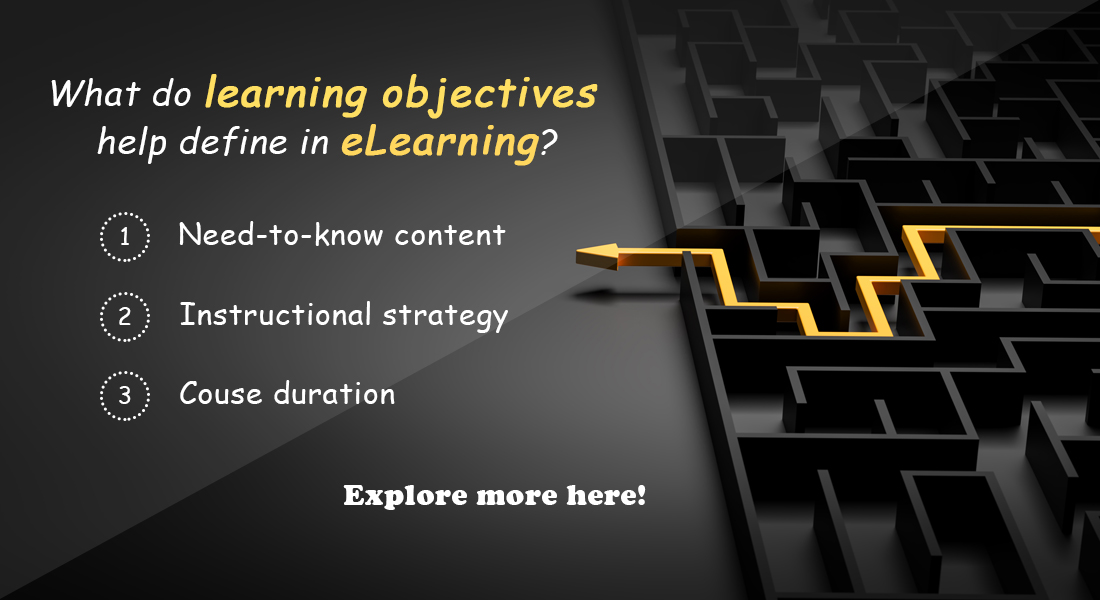Importance of Learning Objectives in eLearning

“To reach a port, we must sail—Sail, not tie at anchor—Sail, not drift.”– Franklin Roosevelt
As an Instructional Designer, it could be your worst nightmare if the Learners meander through the course you develop, with no idea of what is being taught, what are the key learning points and what is expected of them after taking the course.
→ Download Now: Instructional Design 101
In instructional design, there is a simple recipe to avoid this………Learning Objectives. Set them right and you will set your course and learners on the right track.
What are Learning Objectives?
A Learning Objective is a statement, in specific and measurable terms that describes what the learners will be able to do, as a result of engaging in a learning activity. The components of a learning objective are Performance, Condition, Criteria. Learning Objectives form the basis for deciding:
- Scope of content
- Choice of instruction method
- Evaluation method
- Course duration
- Course cost
What are Learning Objectives?
- Learning Objectives are your one-stop solution. They are used to specify the intended outcome of the course, or in other words what you want your learner to learn.
- Learning Objective is a statement, in specific and measurable terms that describes what the learners will be able to do, as a result of engaging in a learning activity.
- As we all know, learning cannot be measured, hence it is the learning objective that makes an attempt to determine or assess, what the learner will be able to do, when he engages himself in a learning activity.
Why are Learning Objectives important in eLearning?
As the direct presence of an instructor is not possible in an eLearning course, learning objectives are the only way to guide the learners, along the right track in the course and keep them aligned with the expected outcomes.
They ensure that the course content is consistent with the objectives and helps avoid extraneous content. Learning objectives are an essential part of any instructional design strategy and form the foundation for decisions such as:
Learning Objectives form the basis for deciding:
- Scope of content
- Choice of instruction method
- Evaluation method
- Course duration
- Course cost
These steps help create the right kind of course, for the right kind of audience.

Instructional Design 101
A Handy Reference Guide for eLearning Designers
- eLearning standards
- Streamlined instructional design process
- Effective assessments
- And More!
How to set effective Learning Objectives?
Setting apt learning objectives is more than half the battle won, in an eLearning course.
For learning objectives to be effective, realistic and measurable, they should align with key instructional design principles and contain three components as propounded by Robert Mager:
- Performance
- Condition
- Criteria
1. Performance:
This specifies where the learning has to bring about behavioral changes in the learners. As an instructional designer, your course should always aid your learners improve, rather than reduce their performance level.
2. Condition:
Specifies the constraints under which the learners will be expected to perform. This helps prevent misconstruing the content. Condition is the trickiest element, when it comes to setting objectives. The condition set in a particular environment, may not be apt or relevant when learners of a different environment take the course.
3. Criteria:
Specifies the acceptable level of performance. Tells learners how they need to perform, for the course to be considered complete.
False Learning Objectives
Many a times we write objectives which do not necessarily coincide with the matter within the course, they appear as an objective, but do not contain performance nor do they specify what the learner will be able to accomplish. Such pitfalls should be avoided.
Repercussions of not setting Learning Objectives correctly
When inappropriate, learning objectives can wreak havoc with the learning process. They tend to do more harm than good. The learner’s miscomprehension of the course leads to chaos and the course intent/functionality (objectivity) is completely lost!
Happy Setting of Learning Objectives!!!
Hope this blog was helpful in providing pointers to proceed in the right direction.





